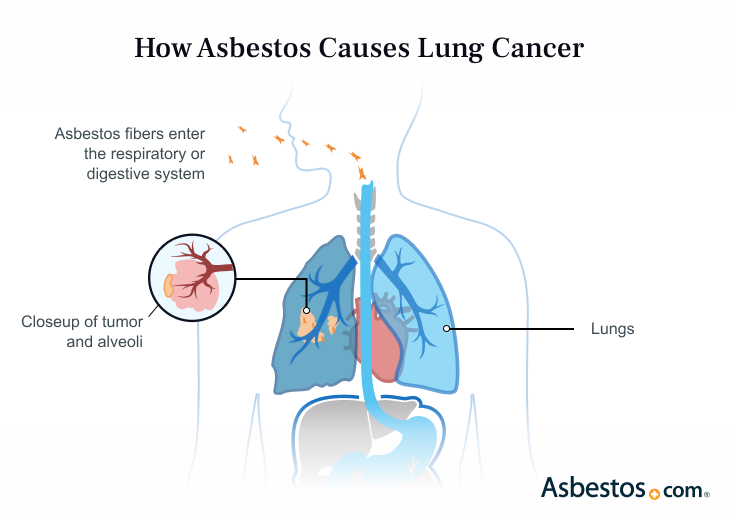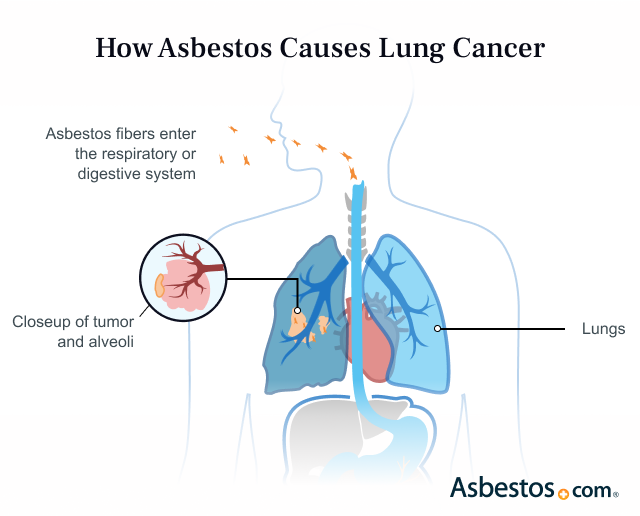Hildy Grossman is a lung cancer survivor who loves performing on stage. She sings for the joy of the song and the thrill she feels as a cabaret entertainer. Today she sings to save lives. Hildy’s turned her lifelong passion for musical theater into a beacon of hope. She’s created a nonprofit to support much-needed lung cancer research. It’s a volunteer-powered fundraising arm built around performing arts.
Asbestos-Related Lung Cancer
Asbestos exposure puts people at a higher risk of developing lung cancer. In fact, breathing in asbestos fibers can make lung cancer 5 times more likely. It can take 15 to 35 years after exposure for asbestos-related lung cancer to develop.
What Is Asbestos-Related Lung Cancer?
Asbestos-related lung cancer is a type of cancer that starts inside the lungs after a person breathes in asbestos fibers. Its tumors usually form in the airways or tiny air sacs that help the body take in oxygen.
It usually takes decades for asbestos lung cancer to develop after exposure. The risk follows a dose response, meaning it increases with both the amount and length of time someone is exposed to asbestos fibers.
Key Facts About Asbestos Lung Cancer
- Approximately 4% of U.S. lung cancers are asbestos-related.
- Combining smoking with asbestos exposure multiplies lung cancer risk fivefold.
- Lung cancer symptoms can take 15–35 years to develop after asbestos exposure.
- Smoking greatly increases lung cancer risk for those exposed to asbestos.
Tumors most often develop in the upper lobes of the lungs. This may be because of how inhaled asbestos fibers settle and how air flows through the lungs. Spotting asbestos lung cancer tumors early in these areas can help guide faster treatment decisions.
Lisa Knickerbocker tells us when she was first diagnosed with lung cancer more than 20 years ago she was scared and overwhelmed. Her advice now, “The first thing I would tell others is `You can have the best doctor in the world. Don’t let anyone tell you can’t.’ Do your homework, and don’t settle for anything less. You hear about others all the time who settle for less. Don’t do that.”
Mesothelioma vs. Asbestos-Related Lung Cancer
Mesothelioma and asbestos lung cancer stem from the same exposure, but they’re not the same diagnosis. Mesothelioma is a cancer that starts in the lining around organs, called the mesothelium. Pleural mesothelioma, the most common type, begins in the lining around the lungs. Because it affects this area, mesothelioma is sometimes confused with lung cancer.
Doctors use the same tests to diagnose both types of cancer. Both asbestos-related lung cancer and mesothelioma have long latency periods. They often take decades before symptoms appear. When symptoms develop, the cancers can grow rapidly.
These cancers grow in different ways and require different treatments. Lung cancer linked to asbestos is diagnosed nearly 6 times more often than mesothelioma. Among illnesses related to asbestos exposure, lung cancer is the leading cause of death.
What Are the Types of Asbestos Lung Cancer?
The 2 main types of asbestos lung cancer are: non-small cell lung cancer and small cell lung cancer. About 80% to 85% of asbestos-related lung cancer is NSCLC, and 10% to 15% is SCLC.
SCLC differs from NSCLC in its aggressiveness and microscopic formation. SCLC consists of smaller cancer cells that resemble oats. When compared to NSCLC’s larger cancer cells, the cells in SCLC look smaller and more alike or homogeneous.
Non-Small Cell Lung Cancer
Non-small cell lung cancer is the more common type associated with asbestos exposure. NSCLC tends to grow less aggressively than SCLC. There are 3 main classifications of NSCLC: adenocarcinoma, squamous cell carcinoma and large cell carcinoma.
Small Cell Lung Cancer
Small cell lung cancer is the less common type associated with asbestos exposure. SCLC grows much more quickly than NSCLC. SCLC also spreads throughout the body much faster. In order to treat SCLC effectively, it must be addressed early and aggressively.

Get help paying for treatment and other expenses by accessing trust funds, grants and other options.
Access Funds NowHow Does Asbestos Cause Lung Cancer?
Asbestos changes the DNA of cells to cause lung cancer. Breathing in asbestos fibers lets them settle deep in the lungs. These fibers gradually irritate the lung cells and kill them. Eventually, inflammation takes place and then scarring, called fibrosis.
A 2025 Science Direct study listed asbestos and other environmental pollutants as one of the most significant risk factors for lung cancer. Asbestos is the most reported work-related lung cancer according to a recent global study in SciELO. It determined 37.5% of all work-related lung cancer cases had a link to asbestos exposure. The military’s heavy use of asbestos put veterans and civilian workers at higher risk. Mining, construction, heavy industry, shipbuilding and firefighting are also higher-risk groups
Not everyone who inhales asbestos will develop lung cancer. However, high levels of long-term asbestos exposure will create a significant risk.
Steven M. Markowitz, M.D., DrPH, directs the Barry Commoner Center for Health and the Environment at City University of New York. He says all types of asbestos cause both lung cancer and mesothelioma. But he explains, “longer, thinner fibers have a stronger association with lung cancer.”


What Are the Symptoms of Asbestos-Related Lung Cancer?
Asbestos-related lung cancer causes shortness of breath, a cough and chest pain. Lung cancer from asbestos, smoking or other causes has the same symptoms. These symptoms resemble other respiratory conditions ranging from pneumonia to mesothelioma. This often delays diagnosis.
Asbestos Lung Cancer Symptoms
- Chest pain
- Chronic respiratory infections
- Coughing up blood
- Fatigue
- Hoarseness or wheezing
- Loss of appetite
- Persistent coughing
- Shortness of breath
- Swelling of the face or neck
- Weight loss
Symptoms usually only appear in lung cancer’s later stages, when it’s harder to treat. In a 2025 study in Science Direct, 38% of people with a higher risk of lung cancer declined a chest CT screening because they had no symptoms.
If you have past asbestos exposure, regular cancer screenings can help your doctor catch cancer early. An early diagnosis can improve your treatment options and overall outlook.
How Is Asbestos-Related Lung Cancer Diagnosed?
Doctors diagnose asbestos-related lung cancer via several critical steps. They begin with a comprehensive medical and occupational history. This discussion with your doctor is very important. Knowing how long and how much exposure there was can help with diagnosis and treatment.
Steps in Diagnosing Asbestos Lung Cancer
- Review of medical and asbestos exposure history.
- Imaging tests such as chest X-rays, CT scans and PET scans.
- Bronchoscopy or needle biopsy procedures to obtain tissue samples.
- Pathological analysis (cytology) to confirm cancer type and stage.
This detailed analysis is very important because it helps healthcare providers create personalized treatment plans. Accurate diagnosis through these steps is also key to managing asbestos-related lung cancer effectively.
What Are the Treatment Options for Asbestos-Related Lung Cancer?
Treatment for asbestos-related lung cancer includes surgery, chemo, radiation and immunotherapy. Surgery aims to remove tumors. Chemo kills cancer cells and radiation prevents recurrence. Immunotherapy can boost the body’s own immune system to fight cancer cells.
Keytruda, Opdivo, Libtayo, Imfinzi and Tecentriq are commonly used. These are all both immunotherapies and targeted therapies. They’re monoclonal antibodies, which are lab-made proteins. They target immune checkpoint proteins. Cancer cells use these natural “off switches” to hide from the immune system.
Treating Asbestos Lung Cancer
- Chemo: Common if cancer has spread. Cisplatin-based chemo shrinks tumors and kills cancer cells.
- Immunotherapy and targeted therapy: Standard, first-line options for NSCLC include Keytruda, Opdivo, Libtayo, Imfinzi and Tecentriq.
- Radiation therapy: Uses high-energy rays to kill cancer cells or slow growth. It can help prevent cancer from coming back.
- Surgery: If caught early, doctors can remove the tumor and a small piece, called a lobe of the lung, or they can remove the whole lung in a pneumonectomy.
The National Comprehensive Cancer Network Guidelines provide widely recognized protocols for lung cancer treatment. These include therapies effective for asbestos-related cases. Sean Marchese, RN, tells us, “The most common surgery for asbestos lung cancer is a lobectomy. That means the surgeon removes a lung lobe with the most cancer.”
Clinical trials might offer new treatment options. How well a person does depends on their cancer stage, health, and how they respond to treatment. Personalized care and regular check-ups can help them live longer.

Get specialized treatment from experienced mesothelioma doctors.
Find a Doctor NowWhat Is the Average Survival Rate for Asbestos Lung Cancer?
The average survival rate for asbestos lung cancer depends on the stage at diagnosis and the effectiveness of treatment received. Early-stage detection has considerably higher survival rates compared to advanced stages.
According to CDC data, early-stage lung cancer has a 5-year survival rate of approximately 61%. Advanced lung cancer survival rates significantly decrease to around 9%. Early detection through regular medical screenings significantly improves survival chances.
A 2024 Korean study found 66% of people with asbestos-related lung cancer lived 5 years or more. Fewer than 50% of all lung cancer patients survive more than 1 year after their diagnosis. An asbestos lung cancer prognosis depends on cancer type, subtype, overall health and how far the cancer has spread.
Asbestos Lung Cancer Legal Options
People with asbestos lung cancer can file an asbestos lung cancer lawsuit to help cover the cost of treatment and lost wages. Those who lose a loved one may file a wrongful death lawsuit. In 2024 there were 1,644 asbestos lung cancer lawsuits filings in the U.S. That’s a 4% increase from 2023, the biggest jump for any asbestos-related disease.
Our Patient Advocates can match you and your family with an asbestos attorney who has a record of success with cases like yours and is someone you and your family will feel comfortable working with. An experienced lawyer can help you seek compensation to cover medical expenses, travel costs and lost wages. Our VA-accredited claims agents will also help you file claims for VA benefits if your exposure happened during military service.
Most lawsuits end in a settlement. Your asbestos lung cancer lawyer will work to negotiate a favorable asbestos lung cancer settlement for you and your loved ones. Both smokers and nonsmokers can qualify if asbestos exposure is the root cause of your cancer. If your case does go to trial, your lawyer will manage litigation for you so you can focus on your health.
Common Questions About Asbestos-Related Lung Cancer
- What types of lung cancers does asbestos cause?
-
Asbestos exposure can cause any type of lung cancer. People with a smoking history are more susceptible to asbestos-related lung cancer. Asbestos is also the primary cause of pleural mesothelioma, a cancer that forms in the lining around the lungs and isn’t the same as lung cancer.
- Does everyone exposed to asbestos get lung cancer?
-
Not every person exposed to asbestos will develop lung cancer or other asbestos-related diseases. A person’s risk of illness will increase as their exposure to asbestos increases. Heavy and long asbestos exposure presents the highest risk.
- How do doctors link lung cancer to asbestos?
-
The Helsinki Criteria helps doctors determine if asbestos is the primary cause of lung cancer. Diagnosis of asbestosis, higher-than-normal levels of asbestos fibers in lung tissue and heavy exposure history are all criteria. Lung cancer must have developed at least 10 years after the initial exposure to asbestos.
- What is the difference between mesothelioma and asbestos-related lung cancer?
-
All forms of lung cancer start inside the lungs. Mesothelioma is also cancer, but it develops in the tissue lining the outside of the lungs, chest cavity and abdomen. Asbestos exposure can cause both types of cancer.




